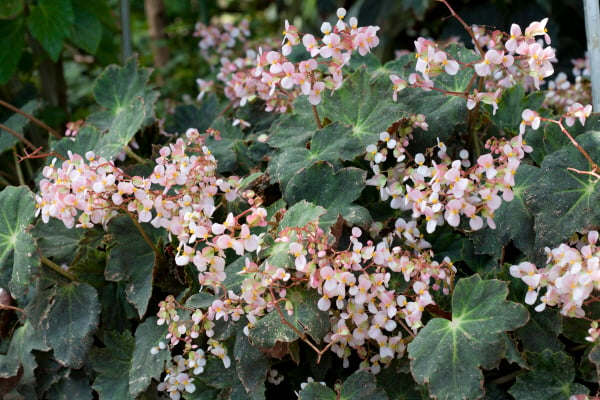Begonia heracleifolia
star begonia
A rhizomatous species whose palmate leaves have white principal veins, a green inner zone and a darker outline. Their undersides are burgundy and the leaf stems are spotted with red. Flowers may be pale pink or white and are held in upright clusters
Other common names
star leaf begoniaSynonyms
Begonia trigonopteraBegonia radiata
see moreBegonia punctata
Begonia tanacetifolia
Begonia heracleifolia var. punctata
Begonia longipila
Begonia jatrophifolia
Begonia heracleifolia var. longipila
Begonia heracleifolia var. nigricans
Begonia nigrescens
Size
Ultimate height
0.5–1 metresTime to ultimate height
2–5 yearsUltimate spread
0.5–1 metresGrowing conditions
Moisture
Moist but well–drainedpH
NeutralColour & scent
| Stem | Flower | Foliage | Fruit | |
| Spring | Green Red | Green Red | ||
|---|---|---|---|---|
| Summer | Green Red | Green Red | ||
| Autumn | Green Red | Green Red | ||
| Winter | Green Red | Pink White | Green Red |
Position
- Partial shade
Aspect
North–facing or West–facing or East–facing
Exposure
Sheltered Hardiness
H1BBotanical details
- Family
- Begoniaceae
- Native to GB / Ireland
- No
- Foliage
- Semi evergreen
- Habit
- Matforming
- Potentially harmful
- Ornamental bulbs - not to be eaten. Wear gloves and other protective equipment when handling. Pets: Ornamental bulbs - not to be eaten - see the HTA guide to potentially harmful plants for further information and useful contact numbers
- Genus
Begonia can be annuals, evergreen or deciduous perennials or shrubs, with fibrous, tuberous or rhizomatous roots and usually asymmetrical leaves, often strikingly patterned, and small or large flowers, both male and female in the same cluster
- Name status
Correct
- Plant range
- Mexico to Honduras
How to grow
Cultivation
May go dormant after flowering, in which case, reduce watering and keep on the dry side until growth resumes. See begonia cultivation - houseplants
Propagation
Propagate by seed, or divide in spring
Suggested planting locations and garden types
- Patio and container plants
Pruning
Remove dead or damaged leaves and spent flower spikes
Pests
May be susceptible to caterpillars, mealy bugs, mites, glasshouse thrips, vine weevil and aphids
Diseases
May be susceptible to grey moulds, powdery mildews, stem rot and rhizome rot
Get involved
The Royal Horticultural Society is the UK’s leading gardening charity. We aim to enrich everyone’s life through plants, and make the UK a greener and more beautiful place.
